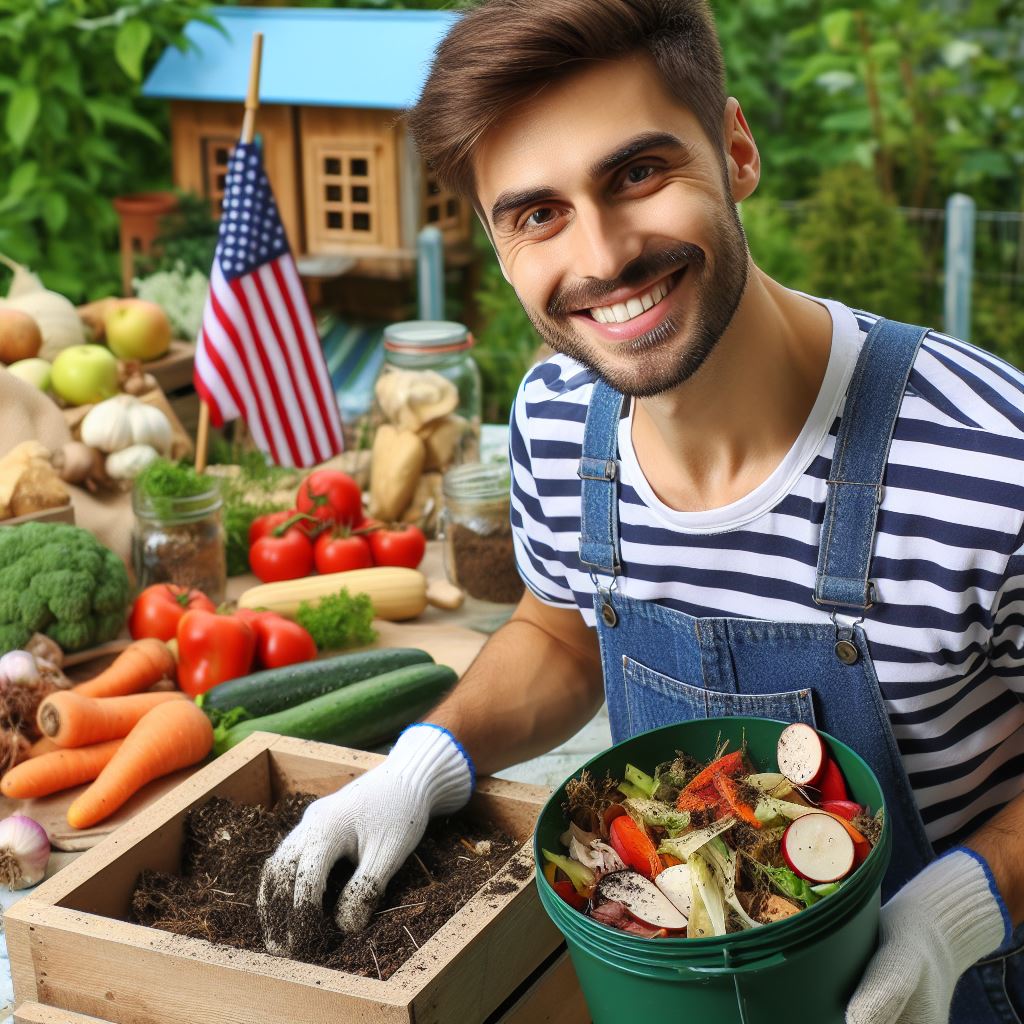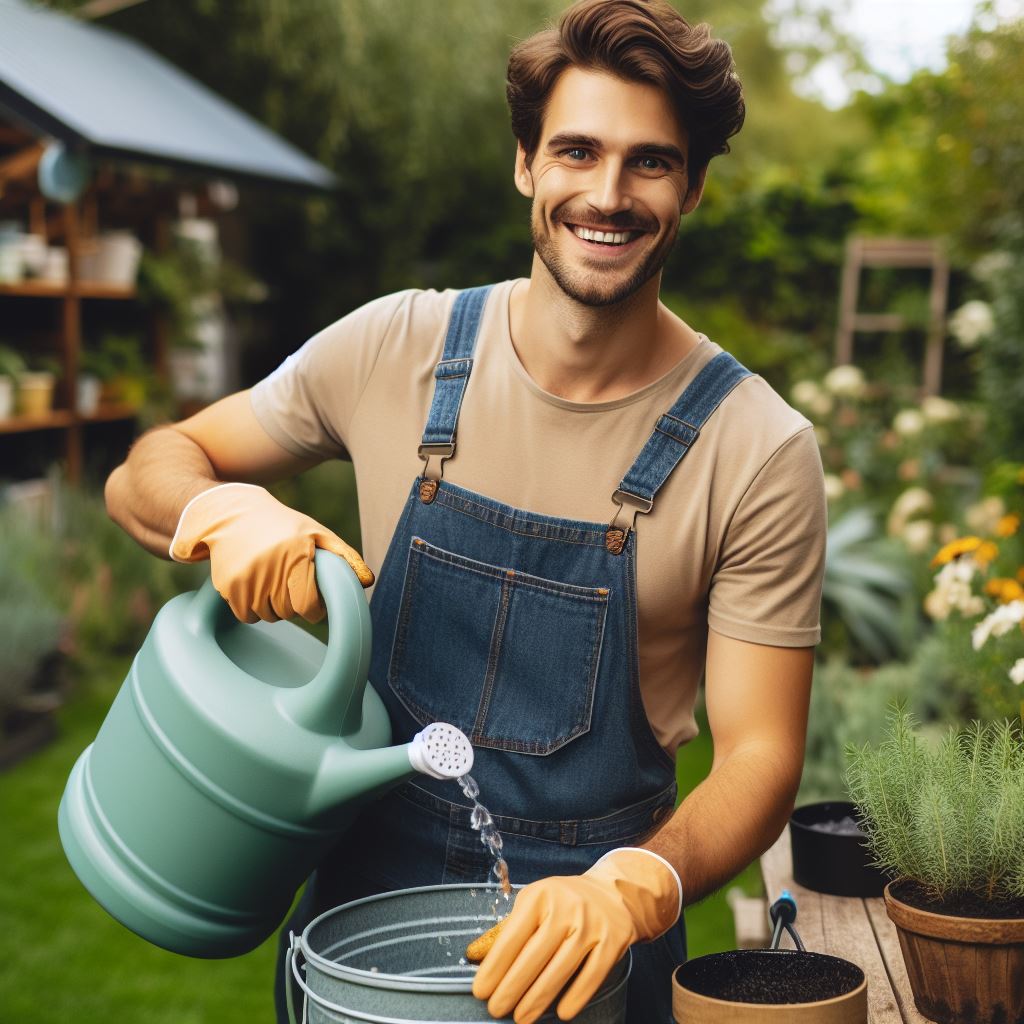Introduction
Composting is a natural process that transforms organic waste into nutrient-rich soil conditioner.
By composting, we can reduce the amount of waste that goes to landfills and incinerators.
Composting helps to preserve natural resources and reduce greenhouse gas emissions.
It improves soil quality, increases water retention, and enhances plant growth.
Composting also reduces the need for chemical fertilizers and pesticides.
It provides a sustainable and cost-effective solution for gardening and agriculture.
By composting, we can divert organic waste from landfills, which helps to reduce methane gas emissions.
Composting creates a closed-loop system where organic matter is recycled back into the earth.
It reduces soil erosion and promotes healthier ecosystems by restoring nutrients to the soil.
Composting is accessible to everyone, whether you have a large garden or just a small balcony.
It is a simple and rewarding way to contribute to a more sustainable and environmentally friendly future.
What materials can be composted?
Composting is a fantastic way to reduce waste and create nutrient-rich soil for your garden.
But what exactly can you compost?
Let’s take a look at the materials that can be turned into “garden gold.”
Organic Waste
Organic waste is a key ingredient in composting.
Transform Your Agribusiness
Unlock your farm's potential with expert advice tailored to your needs. Get actionable steps that drive real results.
Get StartedKitchen scraps like fruit and vegetable peelings, coffee grounds, tea bags, and eggshells are all excellent candidates for composting.
These materials break down easily and add valuable nutrients to your compost pile.
Yard Waste
In addition to kitchen scraps, yard waste can also be composted.
Grass clippings, leaves, small branches, and even weeds (as long as they haven’t gone to seed) can be added to your compost pile.
These materials provide carbon, which is essential for a healthy composting process.
Paper Products
Paper products can also be composted.
Shredded newspaper, cardboard, and paper napkins or towels can all be added to your compost pile.
However, avoid adding glossy or coated paper, as these materials may contain chemicals that are not suitable for composting.
Microorganisms
Microorganisms play a vital role in the composting process.
They break down organic matter, helping it decompose more quickly.
To encourage the growth of microorganisms, consider adding a compost starter or simply introduce some garden soil or finished compost to your pile.
What Not to Compost
While many organic materials can be composted, there are a few items you should avoid.
Meat, dairy products, and oily substances should not be added to your compost pile.
These materials can attract pests or create an unpleasant odor.
Additionally, pet waste should be kept out of your compost pile, as it may contain harmful bacteria or parasites.
Composting Methods
There are several methods you can use to compost, depending on the space and resources available to you.
One common method is a compost bin or pile, where you layer your compostable materials and periodically turn them to promote decomposition.
Alternatively, you can try vermicomposting, which involves using worms to break down organic waste in a controlled environment.
Composting Tips
To ensure successful composting, remember these tips:
- Maintain a balance of carbon-rich (browns) and nitrogen-rich (greens) materials to achieve the ideal carbon-to-nitrogen ratio.
- Be mindful of moisture. Your compost pile should be damp but not waterlogged. If it’s too dry, add water. If it’s too wet, add dry materials like leaves or shredded newspaper.
- Turn your compost regularly to provide oxygen and facilitate decomposition.
- Patience is key. Composting takes time. Depending on the materials and methods used, it may take several months to a year for your compost to fully mature.
- Use your finished compost! Once your compost has broken down into a dark, crumbly mixture, it’s ready to be used in your garden. Spread it on your flower beds, mix it into potting soil, or use it as a top dressing for your plants.
Composting is not only environmentally friendly but also a practical way to reduce waste and improve your garden.
By composting regularly and using your garden’s “gold,” you can contribute to a more sustainable future while enjoying the benefits of nutrient-rich soil. Happy composting!
Read: Urban Farming Essentials for Small Spaces
Setting up a Composting System
Choosing the Right Location: A Sunny Spot, Well-Drained Area
- Find an area in your yard that receives plenty of sunlight for your compost pile.
- Ensure the location has proper drainage to prevent excessive moisture buildup.
Selecting a Composting Container or Bin: Options and Considerations
- Decide whether you want an open pile or a container for your composting system.
- Consider factors like space, aesthetics, and ease of turning when selecting a container.
Layering the Compost Pile: Balance of Green and Brown Materials
- Start by adding a layer of brown materials, such as dry leaves or straw, to your compost pile.
- Next, add a layer of green materials, like fruit scraps or grass clippings, to provide nitrogen.
- Continue alternating layers of brown and green materials until the pile is about 3 feet high.
Turning and Aerating the Compost for Decomposition
- Use a pitchfork or compost aerator to regularly turn your compost pile.
- Turning the pile helps mix the materials, allowing for better decomposition and aeration.
- Aim to turn the compost every 3-7 days, ensuring the outer materials move to the center and vice versa.
- Aerating the compost improves oxygen flow, preventing foul odors and promoting faster decomposition.
Choosing the Right Location: A Sunny Spot, Well-Drained Area
In order to set up a successful composting system, it is crucial to consider various factors and follow the right steps.
The location of your compost pile plays a significant role in its overall success.
Showcase Your Farming Business
Publish your professional farming services profile on our blog for a one-time fee of $200 and reach a dedicated audience of farmers and agribusiness owners.
Publish Your ProfileChoose a spot in your yard that receives ample sunlight, as it helps accelerate the decomposition process.
Additionally, ensure the area has proper drainage to prevent the compost from becoming waterlogged.
Selecting a Composting Container or Bin: Options and Considerations
Once you have determined the right location, it’s time to choose a composting container or bin.
There are numerous options available, including open piles, compost tumblers, or enclosed bins.
Consider your available space, aesthetic preferences, and the ease of turning when selecting the container that suits your needs best.
Layering the Compost Pile: Balance of Green and Brown Materials
Layering the compost pile with the right balance of green and brown materials is essential for proper decomposition.
Begin by adding a layer of brown materials like dry leaves or straw, which provide carbon.
On top of the brown layer, add green materials such as fruit scraps or grass clippings, which supply nitrogen.
Alternate these layers until your compost pile reaches a height of around 3 feet.
Turning and Aerating the Compost for Decomposition
Regularly turning and aerating the compost pile promotes decomposition and prevents unpleasant odors.
Use a pitchfork or compost aerator to mix the materials thoroughly.
Turning the pile allows the outer materials, which may be less decomposed, to be exposed to the center, where decomposition is more advanced.
Aim to turn the compost every 3-7 days for optimal results.
Aerating the compost is equally important as it improves oxygen flow and ensures a healthy decomposition process.
Sufficient oxygen levels prevent the growth of anaerobic bacteria, responsible for foul-smelling odors.
By turning and aerating your compost regularly, you create a balance between decomposition and aeration, resulting in nutrient-rich compost for your garden.
Essentially, setting up a composting system involves selecting the right location, choosing a suitable container, layering the materials correctly, and maintaining proper aeration through regular turning.
By following these steps, you can turn your household waste into valuable garden gold, improving plant growth and reducing your environmental impact.
Read: Starting Organic Gardens: A Beginner’s Guide
Managing the composting process
Composting is a natural and sustainable way to transform organic waste into nutrient-rich soil that can benefit your garden.
However, to achieve successful composting, proper management of the composting process is essential.
Monitoring the moisture content
One of the key aspects of managing composting is maintaining the right moisture level.
The compost pile should be damp but not overly wet.
To ensure the ideal moisture content, you can regularly check the compost pile’s moisture by squeezing a handful of composting materials.
If a few drops of water come out without excess moisture, the pile is properly moistened.
Controlling the temperature
Temperature plays a vital role in the composting process.
The optimal temperature range for decomposition is between 135°F and 160°F (57°C and 71°C).
This temperature allows microorganisms to thrive and break down organic matter effectively.
To control the temperature, regularly turn the compost pile to introduce oxygen, which helps maintain the desired temperature range.
Adding necessary amendments
Composting materials should have a proper carbon-to-nitrogen ratio for efficient decomposition.
Adding amendments such as manure, shredded paper, or wood chips helps balance the carbon-to-nitrogen ratio and improve the composting process.
Manure provides nitrogen, while shredded paper and wood chips increase carbon content.
Avoiding common composting problems
While composting, certain issues may arise, including pests, odor, or excessive moisture.
To prevent pests, avoid adding meat, dairy, or oily food scraps to the compost pile.
To control odor, ensure proper aeration and avoid anaerobic conditions by regularly turning the compost.
Excessive moisture can be managed by adjusting the compost pile’s structure and adding dry materials like leaves or straw.
In general, managing the composting process involves monitoring moisture content, controlling temperature, adding necessary amendments, and avoiding common problems.
By following these guidelines, you can successfully turn your organic waste into nutrient-rich garden gold!
Read: Urban Permaculture: Sustainable Tips

How long does composting take?
Composting is a natural process that transforms organic waste into nutrient-rich soil, known as compost.
Showcase Your Farming Business
Publish your professional farming services profile on our blog for a one-time fee of $200 and reach a dedicated audience of farmers and agribusiness owners.
Publish Your ProfileThe time it takes for composting to occur depends on several factors:
Factors influencing the decomposition process
- Materials used: The type and composition of the organic materials being composted can affect the speed of decomposition. Some materials break down more easily than others.
- Temperature: Composting is faster in warm temperatures, as microorganisms responsible for the decomposition process are more active. Heat accelerates the breakdown of organic matter.
- Moisture: Adequate moisture levels are essential for the decomposition process. Microorganisms require moisture to thrive and break down the organic materials effectively.
- Aeration: Sufficient airflow within the compost pile allows oxygen to reach the microorganisms, enhancing their activity and speeding up the decomposition process.
- Particle size: Finely shredded organic matter decomposes faster than larger pieces, as it provides a larger surface area for microorganisms to work on.
- Carbon-to-nitrogen ratio: The ideal carbon-to-nitrogen ratio in the compost pile is around 30:1. The correct balance ensures efficient decomposition.
Timeframe for different types of compost
Hot Composting
Hot composting refers to the traditional method of composting, where the pile reaches high temperatures and undergoes rapid decomposition.
This method typically takes:
- About 1-3 months for the compost to go from raw materials to finished compost.
- The decomposition process is quicker due to the high temperatures generated, usually between 130-160°F (55-71°C).
- Turning the pile regularly and maintaining the right conditions can speed up the process.
Cold Composting
In cold composting, also known as passive composting, decomposition occurs at a slower pace without the need for frequent turning and monitoring.
This method usually takes:
- 6 months to 2 years for the compost to fully mature and be ready for use.
- The slower decomposition process is due to lower temperatures, ranging from ambient outdoor temperatures to slightly elevated.
- While it requires less effort, cold composting still produces valuable compost over time.
It’s important to note that these timeframes are general estimates, and variations can occur depending on the specific conditions and techniques used.
Factors like the size of the compost pile, the frequency of turning, and the initial mixture of materials can further influence the duration of composting.
In addition, composting is an efficient way to recycle organic waste and create nutrient-rich soil.
The time it takes for composting to complete depends on the materials used, temperature, moisture, and other factors.
Whether using hot or cold composting methods, patience and proper maintenance will ultimately turn waste into “garden gold.”
Read: Hydroponics: Gardening Without Soil
Using Compost in the Garden
Composting is a fantastic way to turn waste into valuable garden gold.
By recycling organic materials, you can create a nutrient-rich soil amendment that benefits your plants and improves soil health.
In this section, we will explore the different aspects of using compost in the garden.
When is compost ready to use: signs of mature compost
- Finished compost has a dark, rich color and a pleasant earthy smell.
- You should also check for visible signs of decomposition, such as the breakdown of larger organic matter.
- Furthermore, a simple test involves placing a handful of compost in a sealed plastic bag and monitoring it for excessive heat or bad odors.
- If the compost passes all these tests and resembles loose, crumbly soil, it is ready to use.
Methods of applying compost: topdressing, mixing with soil, or creating compost tea
There are several ways to incorporate compost into your garden, depending on your specific needs and preferences.
- Topdressing involves applying a layer of compost on the surface of the soil around plants.
- This method helps suppress weeds, retain moisture, and slowly release nutrients over time.
- Another option is mixing compost directly into the soil before planting.
- This ensures that the nutrients are evenly distributed and readily available to the plants.
- Compost tea is a liquid fertilizer made by steeping compost in water.
- You can use this nutrient-rich solution to water your plants or as a foliar spray to feed the leaves.
- Regardless of the method you choose, it’s important to remember not to over-apply compost.
- A thin layer is usually sufficient, as too much can create imbalances in the soil.
Benefits of compost for plant growth and soil health
Using compost in your garden provides numerous benefits for both plant growth and soil health.
- Compost adds essential nutrients to the soil, such as nitrogen, phosphorus, and potassium, which are crucial for plant growth.
- It also improves soil structure, allowing for better aeration and water drainage.
- Compost acts as a natural fertilizer, promoting healthy root development and overall plant vigor.
- Furthermore, it enhances the soil’s ability to retain moisture, reducing the need for frequent watering.
- Compost encourages beneficial microbial activity in the soil, supporting a diverse ecosystem of organisms.
- This, in turn, helps suppress plant diseases and pests, reducing the need for chemical interventions.
- Moreover, using compost is an eco-friendly practice that reduces waste and lowers your carbon footprint.
- By recycling organic materials, you contribute to a more sustainable and environmentally conscious lifestyle.
In essence, incorporating compost into your garden is a win-win situation.
You turn waste into valuable nutrients while improving the health and productivity of your plants.
So why not start composting today and reap the rewards of garden gold tomorrow?
Conclusion
Recap of the importance and benefits of composting
Composting is a simple yet effective way to turn your waste into valuable garden gold.
It not only reduces landfill waste but also enriches the soil with nutrients and promotes healthy plant growth.
By composting, you can contribute to a more sustainable environment and create a healthier garden.
To recap, the benefits of composting include reducing waste, improving soil quality, saving money on fertilizers, and reducing the need for chemical pesticides.
It also helps to conserve water and reduce greenhouse gas emissions.
Encouragement for readers to start composting and turn their waste into valuable garden gold
If you haven’t started composting yet, now is the perfect time to give it a try.
Start small by setting up a compost bin or pile in your backyard.
Remember to add a mix of green and brown materials, keep it well-aerated, and maintain the right moisture level.
Soon, you’ll see the magic happening as your waste slowly transforms into nutrient-rich soil amendment.
To ensure successful composting, here are some additional tips: avoid adding meat, dairy, or oily foods to your compost, chop or shred larger items for faster decomposition, and turn your compost regularly to encourage breakdown.
Additionally, consider using a compost thermometer to monitor the temperature, aiming for temperatures between 110-160°F for optimal decomposition.
Additional resources or tips for successful composting
If you need further guidance, there are plenty of resources available online.
Websites like the Environmental Protection Agency or the National Resources Defense Council offer comprehensive guides on composting.
Local gardening centers or waste management facilities can also provide valuable information and workshops on composting.
So, let’s take a step towards sustainability and start composting today.
Your garden will thank you, and you’ll be making a positive impact on the environment. Happy composting!




